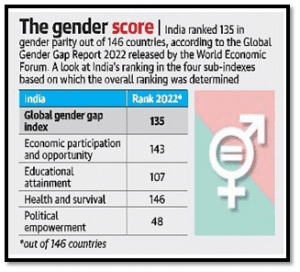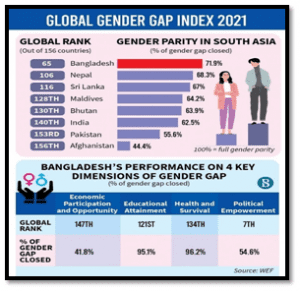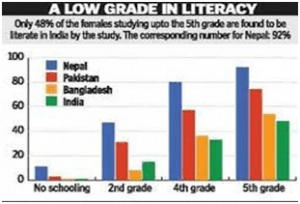Table of Contents
THE CONTEXT: India has ranked low at 135th place out of 146 countries in terms of gender parity, on the annual Gender Gap Report 2022 of the World Economic Forum (WEF).This means, it is only 11 ranks above Taliban-ruled Afghanistan, where women are prohibited from attending schools. This is a grave cause of concern given that India vouches to preach the ideals of liberty and equality in letter and spirit.
THE GENDER GAP REPORT
- The Global Gender Gap index “benchmarks the current state and evolution of gender parity across four key dimensions (Economic Participation and Opportunity, Educational Attainment, Health and Survival, and Political Empowerment)”. According to the WEF, it is the longest-standing index, which tracks progress towards closing these gaps over time since its inception in 2006.
- On each of the four sub-indices as well as on the overall index the GGG index provides scores between 0 and 1, where 1 shows full gender parity and 0 is complete imparity. “The cross-country comparisons aim to support the identification of the most effective policies to close gender gaps,” states the report.
GENDER GAP: KEY FINDINGS
- In 2022, the global gender gap has been closed by 68.1%. At the current rate of progress, it will take 132 years to reach full parity.
- Across the 146 countries covered by the 2022 index, the Health and Survival gender gap has closed by 95.8%, Educational Attainment by 94.4%, Economic Participation and Opportunity by 60.3% and Political Empowerment by 22%.
- Although no country has yet achieved full gender parity, the top 10 economies have closed at least 80% of their gender gaps, with Iceland (90.8%) leading the global ranking. Iceland remains the only economy to have closed more than 90% of its gender gap.


GENDER GAP: ANALYSIS OF THE WIDENING IMPASSE
ISSUE OF CONCERN
ASPECTS COVERED
EVALUATION
GENDER GAPS IN THE WORKFORCE
Percentage of women who are part of the labour force, wage equality for similar work, earned income etc.
- India ranks a lowly 143 out of the 146 countries in contention.
- Women’s participation in the workforce in India has not been rising over the last few decades. A report by the World Bank said that India is one of those countries where less than a quarter of women have joined the labour force and only one-fifth are employed.
- Employment losses due to the COVID-19 pandemic have been significantly worse for women than for men. With increased responsibilities at home, and increasing layoffs, the pandemic has inflicted a healthy blow to efforts surrounding parity in the workforce.
POLITICAL EMPOWERMENT
Includes metrics such as the percentage of women in Parliament, the percentage of women in ministerial positions etc.
- Of all the sub-indices, this is where India ranks the highest (48th out of 146).
- However, notwithstanding its rank, its score is quite low at 0.267. Some of the best-ranking countries in this category score much better. For instance, Iceland is ranked 1 with a score of 0.874 and Bangladesh is ranked 9 with a score of 0.546.
- As per the data compiled by the Inter-Parliamentary Union, of which India is a member, women represent 14.44% of the total members of the Lok Sabha.

EDUCATIONAL ATTAINMENT
Includes metrics such as literacy rate and the enrolment rates in primary, secondary and tertiary education.
- Here India ranks 107th out of 146, and its score has marginally worsened since last year. In 2021, India was ranked 114 out of 156.
- Education for all is one of the major tasks being carried out by the Indian government but still, we have the lowest female literacy rate in Asia.
- India is working but the pace is slow as we haven’t achieved what we should have been so far. As per the report, India’s country-wide female literacy rate is 70.3%, while the male literacy rate is estimated at 84.7%. India’s average literacy rate stands at 77.7%, according to the NSO.

HEALTH AND SURVIVAL
Includes two metrics: the sex ratio at birth (in %) and healthy life expectancy (in years).
- In this metric (In Gender Gap Report), India is ranked last (146) among all the countries. Its score hasn’t changed from 2021 when it was ranked 155th out of 156 countries.
- Women in India face issues like malnutrition, lack of maternal health, diseases like AIDS, breast cancer, domestic violence and many more. Nutrition plays a major role in an individual’s overall health, psychological and physical health status is often dramatically impacted by the presence of malnutrition.
- Globally, about 800 women die every day of preventable causes related to pregnancy and childbirth, and 20 per cent of these women are from India.
- India’s anaemia burden among women is widespread, with 53.1 per cent of non-pregnant women and 50.3 per cent of pregnant women being anaemic as per the NFHS-4 in 2016, where India carries the highest burden of anaemia despite having various programmes and policies for the past 50 years since the launch of National Nutritional Anaemia Prophylaxis Programme in 1970.
DIGITAL DIVIDE
Includes aspects like accessibility to digital devices.
- Women facing intersectional discrimination, living in communities with lower socioeconomic status, have even lower access to connectivity or any digital device, leading to a string of tremendous consequences, sometimes even vital ones.
- According to a WEF study, globally, men are 21% more likely to have access to the internet than women. In the world’s least developed countries, this likelihood rises to 52%.
- Sampark, a local non-profit organization, identified 120 other female students from the same school who were suffering from not having a digital device.

- To be offline today means to miss out on learning and earning, accessing valuable services, and participating in the democratic public debate. The digital divide between people who have internet access and those who do not could be deepening existing gender inequalities, pushing women further to the margins of society.
ENTREPRENEURSHIP GAP
Considers aspects like opportunities and conducive environments for startups led by women
- Women are under-represented in entrepreneurship. For example, in 2018, women were about 60% as likely as men to be self-employed in the EU and this gender gap starts young.
- Young women (20-29 years old) were also about 60% as likely to be self-employed as young men. While the gender gap closed slightly across all age groups since 2002, it was due to a decline in male self-employment rather than growth in female self-employment
- The gender gap in entrepreneurship can be explained by a range of factors, including social attitudes towards women in the labour market, different motivations and intentions in entrepreneurship, and different and greater barriers to business creation (e.g., a lack of entrepreneurship skills, failures in financial markets).
- According to the Global Entrepreneurship Monitor (GEM) project, only 11 percent of women around the world start new businesses 30 percent less than men.
Gender gap in emerging technologies like AI
Considers skillset and other intellectual resources required for careers in AI
- LinkedIn’s analysis found a significant gap between female and male representation among AI professionals – only 22% of AI professionals globally are female.
- As per WEF, over the past four years, men and women have been adding AI skills to their profiles at a similar rate. This means that while women aren’t falling further behind, they also aren’t catching up. If the current trend continues, male AI professionals will continue to outnumber women, even as both genders continue to gain AI skills.
- Other studies have found that only 10-15% of machine learning researchers in the leading technology companies are women; less than 14% of authors of AI research papers are women; and women are under-represented at 17-18% across the largest online global data science platforms.
GENDER GAP: CAUSES OF THE IMPASSE
POVERTY
India is still one of the poorest countries in the world, and it is one of the biggest reasons that lead to gender inequality in India. Despite the availability of education in rural areas, families prefer sending their boys to school rather than the girls of the family, which is one of the biggest disadvantages.
PATRIARCHAL SETUP IN OUR INDIAN SOCIETY
Since time immemorial, India has been an extremely patriarchal society. The patriarchal setup in Indian society contributed to the fundamental inequality between men and women. As women were considered a part of the household belonging to their father or husband, they were unable to get a say in any matters concerning their own development or that of the community at large.
LACK OF EDUCATION OR ILLITERACY
The disparity between the literacy rates of men and women in India is a known issue. Some regional states have higher disparity, while some other states have better disparity. The problem is not that there are few literate women in India, but rather the problem is the lack of awareness among women to use their rights.
LACK OF AWARENESS AMONG WOMEN
One of the major causes of gender inequality is the lack of awareness among women about their rights and their ability to achieve equality. This lack of awareness is often due to the prevailing cultural and social norms, which dictate that women should be subservient to men. It is important to break down these barriers and help women become more aware of their rights so that they can demand equality.
WAY FORWARD: CLOSING IN THE IMPASSE
- The Global Gender Gap report criticizes the rising inequality in the number of women holding offices in India. Passing the Women’s Reservation Bill that proposes to reserve 33 per cent of all seats in the Lok Sabha and in all State legislative assemblies for women could make this situation better. Measures could also be taken to address the gender wage gap across industries.
- According to the estimates of the World Inequality Report 2022, in India, men earn 82 per cent of the labour income whereas women earn 18 per cent of it. So, there is scope to allocate more money towards the gender budget, that aims to ensure that women have access to socio-economic benefits as much as men.
- Article 15 of the Indian constitution states that the state shall not discriminate against any citizen on the grounds of only sex. The irony is that there still is widespread discrimination which is a form of injustice against women. Hence, the present times need to get over the ‘son-meta’ preferences imbibed deep into society.
- Society needs to deconstruct the stereotype of women as limited to household activities only. It is important for all institutions (state, family and community) to respond to women’s specific needs such as bridging gaps in education, renegotiating gender roles, the gender division of labour and addressing biased attitudes.
- A noteworthy intervention by the UK government’s Office for AI saw £18.5 million pledged to boost diversity in AI roles, funding conversion degrees including 1000 scholarships for people from under-represented groups. Such steps are needed in emerging economies like India so as to bring women to the mainstream of development and growth.
- A rights-based approach to development is a framework that integrates the norms, principles, standards and goals of the international human rights system into the plans and processes of development. It is characterized by methods and activities that link the human rights system and its inherent notion of power and struggle with development. This needs to be imbibed into polices framed with the aim of reducing the gender gap.
THE CONCLUSION: During the Vedic Period, women enjoyed equality in all spheres of life. India was a glorified nation, and even other fellow citizens used to hail down because of its greatness. Women enjoyed a special status which consisted of parity in every aspect. In present times, Article 16 of the Indian Constitution states that equal opportunity will be provided for all citizens in office employment under the state. It is time that we reflect this constitutional and moral ethos in letter and spirit. Young Indian women represent aspirational India possibly more than any other grouping today. As Swami Vivekananda has rightly said, “All nations have attained greatness by paying proper respect to women. That country and that nation which does not respect women have never become great, nor will ever be in future.”
QUESTIONS TO PONDER
- “No country can ever truly flourish if it stifles the potential of its women and deprives itself of the contribution of half its citizens.” Discuss in the light of the recently released Global Gender Gap Report.
- “The accentuating chasm between men and women in India has a multidimensional origin.” Examine critically.

